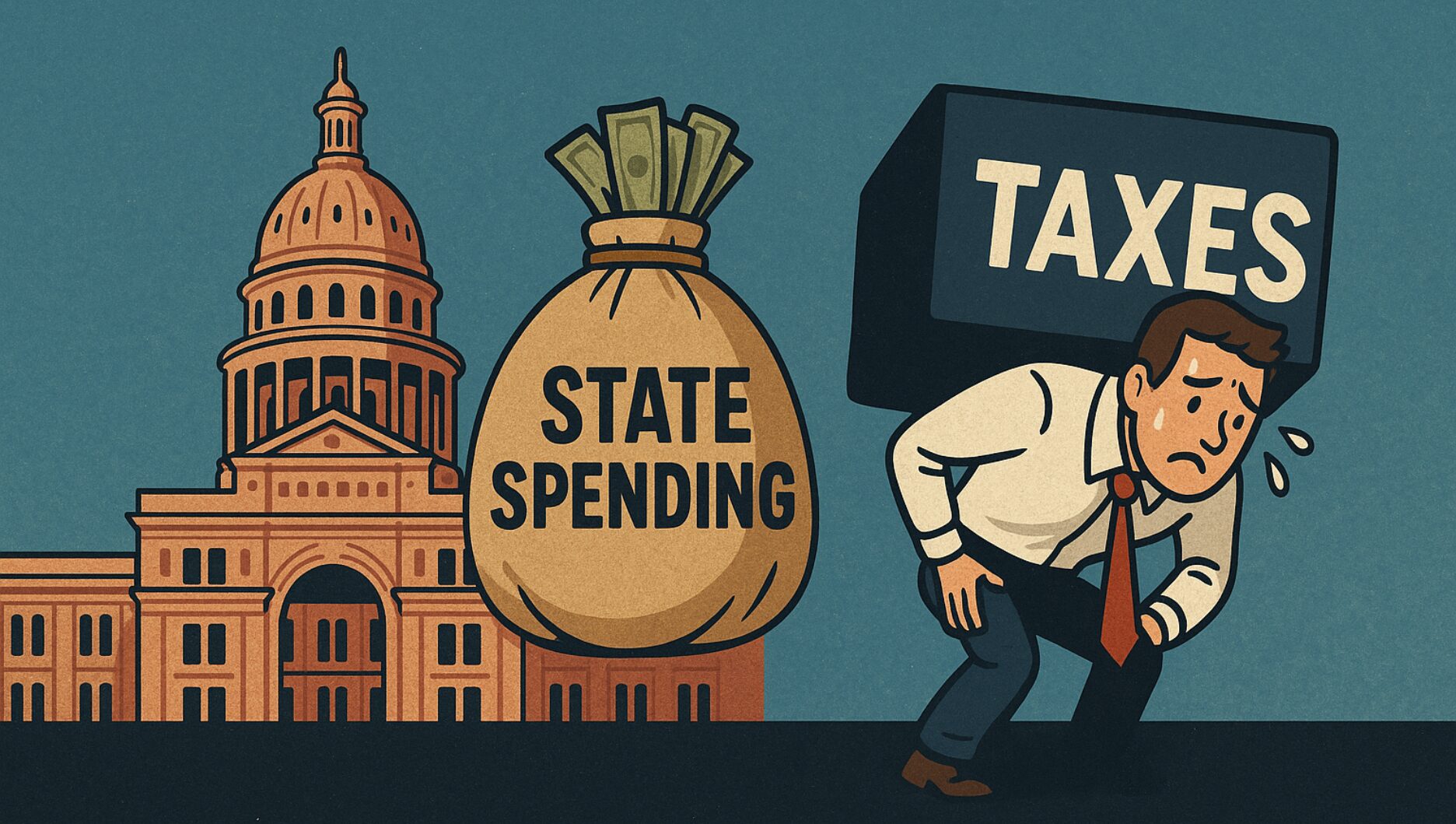
Texas Taxpayers Need a Break
State Funds Spending Up $25 Billion
The Texas Legislature is on the verge of adopting its final budget for the 2026-27 fiscal biennium. Few people are aware of this, but that budget consists of two bills: Senate Bill 1 and House Bill 500. SB 1 is known as the appropriations bill for the 2026-27 biennium, and HB 500 is known as the supplemental appropriations bill that fills in any funding gaps for the 2024-25 biennium. However, most of the taxpayer money appropriated in HB 500 will likely be spent in the 2026-27 biennium. This is because HB 500 appropriates $19.5 billion from the state’s general revenue fund that can be spent during “the two-year period beginning on the effective date of this Act.” Meaning through about the end of May 2027.
Because of this deception in the budget process, and the way it is used to hide the increase in spending from one biennium to the next, we will examine the Texas budget using a much more straightforward approach: comparing how much the Texas Legislature appropriated this session compared to how much it appropriated in 2023.
Figure 1 shows that the Texas Legislature is on the verge of appropriating $251.1 billion in state funds this session. This is $25.6 billion higher than 2023, an 11.3% increase. Much higher than the manipulated increase of $10.9 billion, 4.8%, shown in the official budget documents released by the Legislative Budget Board (LBB).
This paper is focusing on state funds spending for the simple reason is that state funds are the only funds that the Texas Legislature has real control over. Federal funds come and go, and the Legislature often uses this feature to manipulate the numbers to hide spending increases. So in addition to focusing on session to session spending to get an accurate picture of the Texas budget, it is also useful to focus on the appropriation of state funds.
The Budget Exceeds the Constitutional Tax Spending Limit
One reason that the LBB manipulates these numbers is that it allows the Texas Legislature to exceed the Texas Constitution’s Tax Spending Limit in Article VIII, Section 22 which prohibits spending to grow faster than the Texas economy. The growth limit for this session is 8.93%. While the state funds measure used in Figure 1 is broader than the funds that are limited by this limit, the outcome is the same. The LBB’s growth estimate is lower than the 8.93% limit, but the actual growth of state funds appropriations accurately determined is likely higher than the limit.
The LBB says that state spending in SB 1 comes in $10.3 billion under the Tax Spending Limit. Yet if about half of the $19.5 billion of “two-year spending” in HB 500 is spent in the 2026-27 biennium, the Legislature would be in violation of the Tax Spending Limit if the numbers were accurately accounted for.
Beyond this, the Legislature is also appropriating $5 billion into the Energy Fund (SB 1) and $2.5 billion into the Water Fund (HB 500). Because of legislation previously passed, these funds will immediately become constitutionally dedicated. Because of this, they do not count towards the Tax Spending Limit. No voter approval or special legislative vote is needed to make this happen. Adding this $7.5 billion to the $19.5 billion or so that is being shifted backwards into the 2024-25 biennium, it is easy to see that the Texas Legislature is violating the spirit, and perhaps also the letter, of the Texas Constitution’s Tax Spending Limit. This highlights a flaw in the design of the Constitution’s limit; it put a legislative agency, the LBB, in charge of guarding legislative spending. It would be better if the Texas Comptroller was watching over this, just like it does for the Pay-As-You-Go Limit, which prohibits deficit spending by the state.
New Spending Versus Property Tax Relief
Coming into this session, on paper the state had a $24 billion state funds budget surplus that could be given back to Texas taxpayers in the form of property tax relief. But in reality, the surplus was even larger. There was a lot of spending in the 2024-25 budget that were “one-time” expenditures, spending that does not obligate the Legislature to future spending. For instance, there was $13.5 billion of state funds spent through constitutional amendments that were one-time expenditures. Just taking that into account means the Legislature likely had more than $35 billion available for “new spending” this session.
Figure 2 indicates that the Legislature took full advantage of this. It shows that new spending in the 2026-27 budget, which includes both SB 1 and HB 500, tops $37 billion. The included $5 billion for natural gas generators in the Texas Energy Fund, $2.5 billion for contractors and local governments in the Texas Water Fund, and $50 million for the Texas Legislature.
Meanwhile, even though the $24 billion and a lot of the money available for new spending are properly classified as excess taxation, taxpayers received only $6.5 billion in new property tax relief. In other words, new spending was almost six times what the Legislature committed to new property tax relief.
Conclusion
In just the last four years, appropriations of state funds have increased by almost $71 billion, or 42.6%. Property taxes are up $13 billion, or 21.6%, over the same period, despite “record property tax relief” during that period. Texas taxpayers need a break. They need the Texas Legislature to stop the runaway growth of state and local spending. That is not going to happened in this budget, so taxpayers should be getting ready to make that case in 2027.
Charts
| Figure 1: Total Appropriations of State Funds by Session: 2023 vs. 2025 | ||||
| 2023 | 2025 | Increase | % | |
| Primary Appropriations | $216,920,300,000 | $237,092,000,000 | ||
| Supplemental Appropriations | $8,632,700,000 | $14,016,090,771 | ||
| Total | $225,553,000,000 | $251,108,090,771 | $25,555,090,771 | 11.33% |
| Figure 2: Partial List of New Spending of State Funds (HB 500 & SB 1) – 2025 | |
| Education (K-12 and Higher Ed) | $13,885,062,379 |
| Texas Energy Fund | $5,000,000,000 |
| TDCJ COVID-19 Offset | $4,079,169,050 |
| Re-appropriation of Unexpended Funds | $3,706,935,166 |
| Medicaid | $3,450,000,000 |
| Dementia Prevention Research Institute | $3,000,000,000 |
| Texas Water Fund | $2,500,000,000 |
| State Employee Pay Raise | $384,800,000 |
| Film and TV Subsidies | $355,757,969 |
| Nuclear Energy | $350,000,000 |
| Semiconductors | $250,000,000 |
| Texas Legislature | $50,500,000 |
| Total New Spending | $37,012,224,564 |
| New Property Tax Relief | $6,507,100,000 |
Texans for Fiscal Responsibility relies on the support of private donors across the Lone Star State in order to promote fiscal responsibility and pro-taxpayer government in Texas. Please consider supporting our efforts! Thank you!
Get The Fiscal Note, our free weekly roll-up on all the current events that could impact your wallet. Subscribe today!




